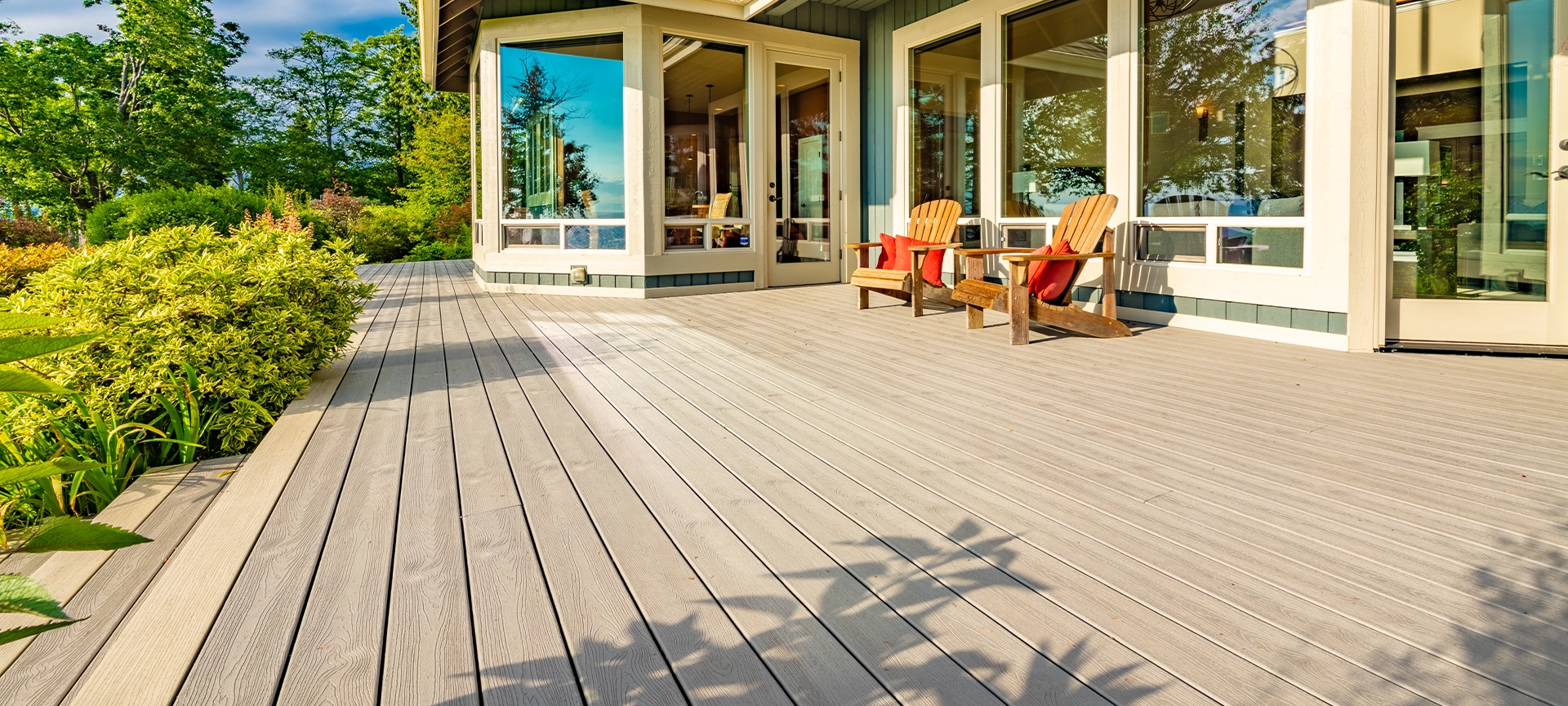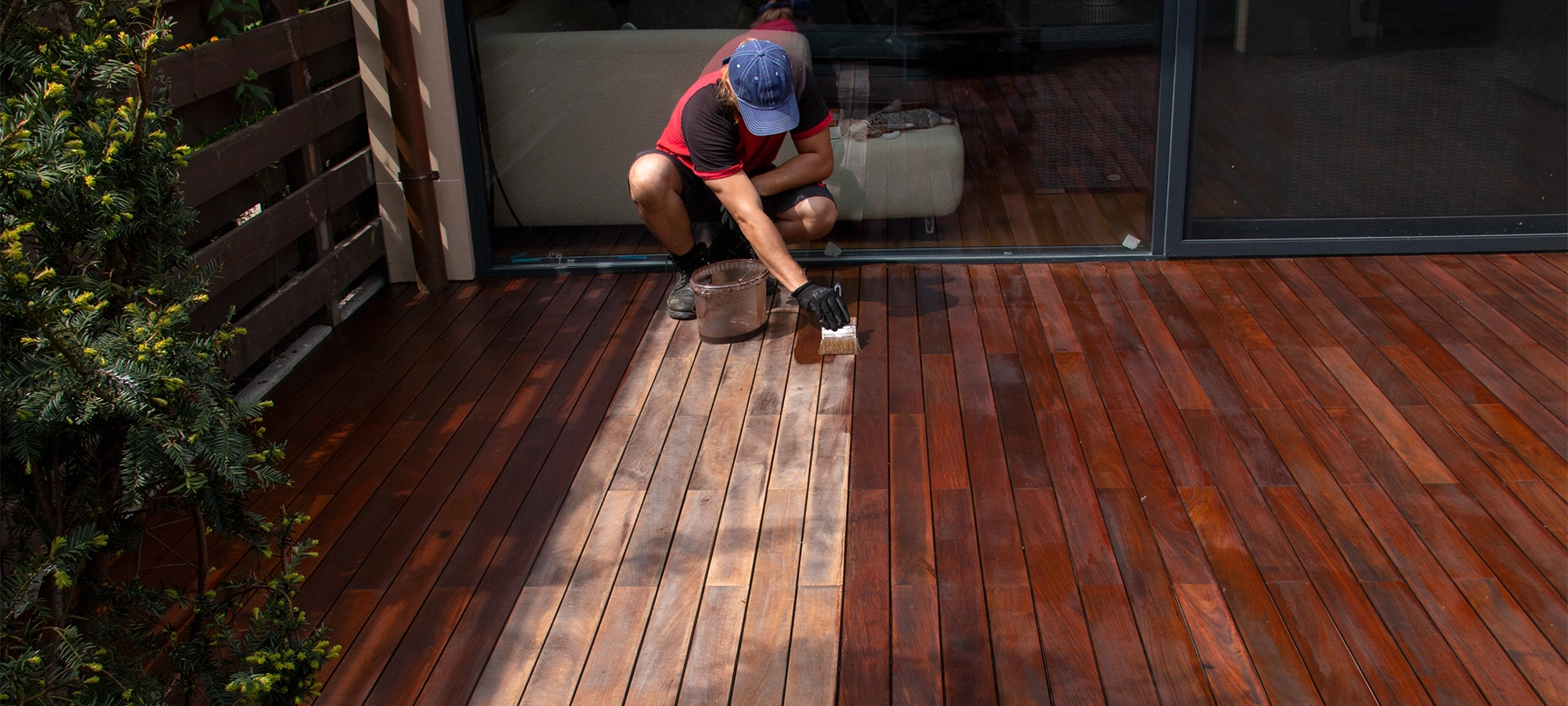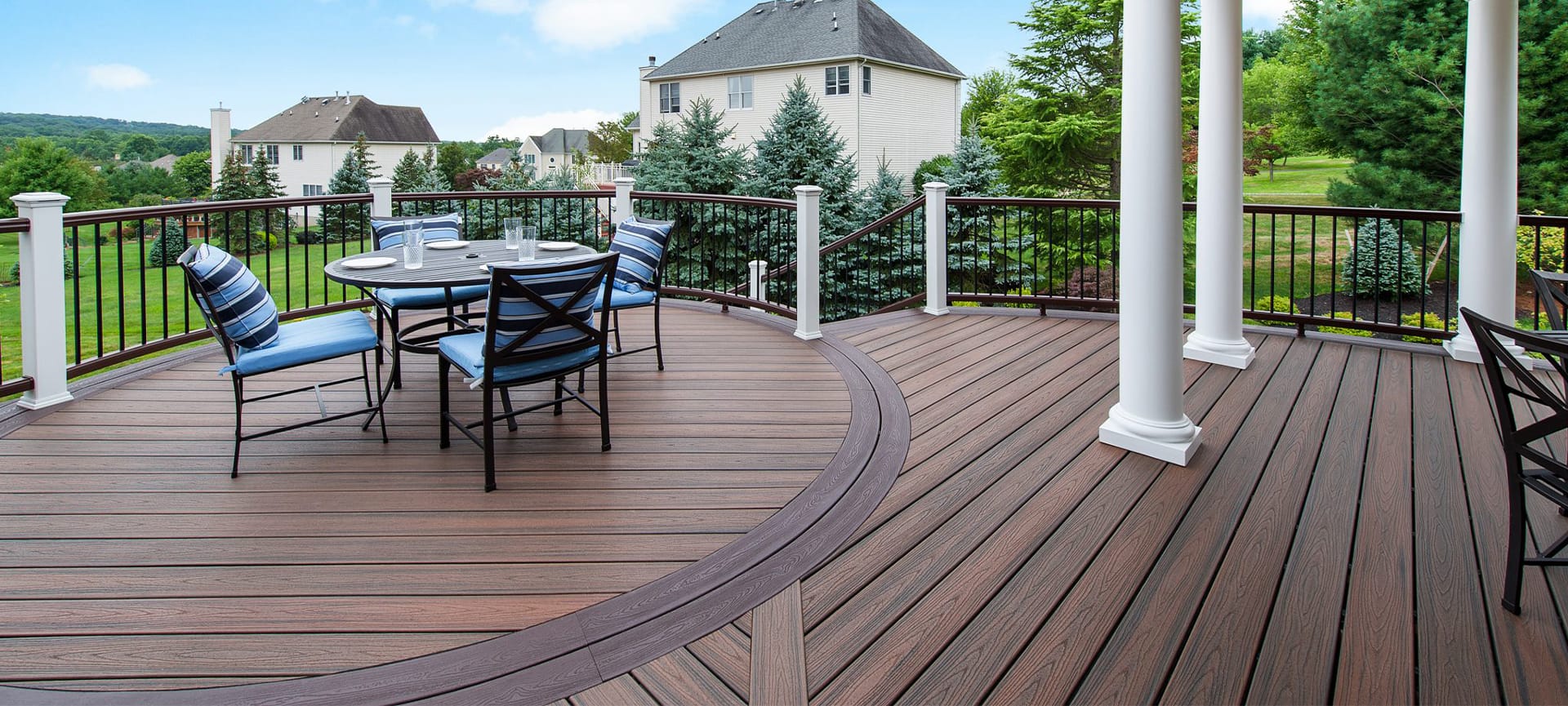
Building a deck is a long-term decision. Once the framing and footings go in, the surface you pick will shape your yard’s style, maintenance routine and resale value for decades.
Among composite brands, TimberTech and Trex dominate Canadian showrooms, and for good reason. Both pair wood-like beauty with a recycled core, yet each takes a distinct path in materials, finishes and warranties.
This guide breaks down the facts so that you can choose with confidence.
Related Article: How Long Does a Deck Last? Lifespan by Material
Comparing the Composite Leaders
TimberTech, owned by The AZEK Company, launched in 1997 and now offers capped polymer and capped composite boards. Trex, founded in 1996, focuses on a single capped composite line split into budget, mid and premium tiers.
TimberTech leans on PVC-rich technology for its high-end lines, delivering lighter boards with deeper embossing. Trex sticks to a blend of reclaimed wood and recycled plastic, banking on brand recognition and consistent grain patterns.
Both brands divert millions of kilos of waste from landfills each year, yet their formulations influence feel underfoot, heat build-up and price.
How Each Board Is Made
A quick primer helps decode showroom labels.
- TimberTech Advanced PVC boards contain roughly 60 percent recycled polyvinyl chloride wrapped in a PVC cap. Its PRO and EDGE series swap the PVC core for a wood–plastic composite (WPC) that still carries a hard-wearing polymer shell.
- TimberTech’s top lines are fully capped on all sides, sealing the board’s groove and underside from moisture. That full-wrap cap adds an extra moisture barrier, helpful in wet backyards or on ground-level frames that stay damp after snow melt.
- Trex boards use a 95 percent recycled WPC core across all tiers—Enhance, Select and Transcend—finished with a three-sided shell.
Material density differs too.
- PVC is lighter, easing lifts during installation and reducing structural load.
- WPC feels closer to wood and carries slightly more mass, which many homeowners equate with sturdiness.
Your preference may swing with how often you move outdoor furniture or the span between joists.
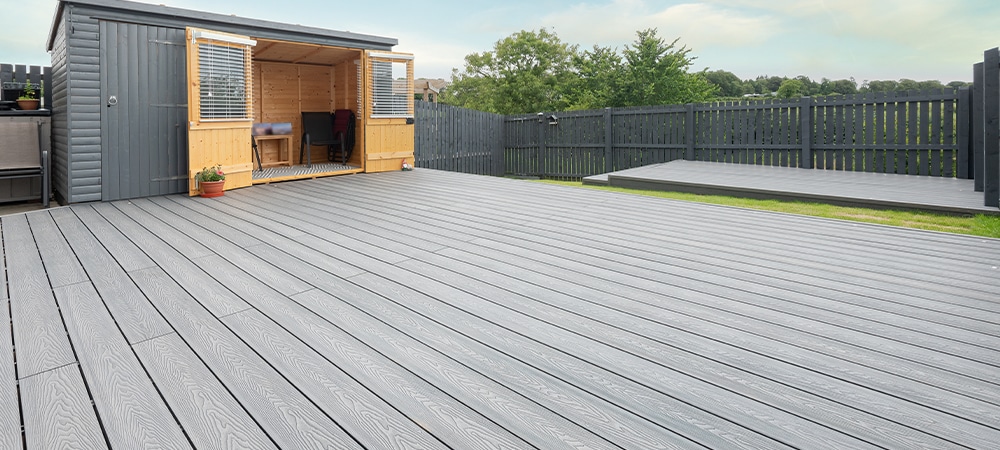
Style and Colour Range
Curb appeal drives many decking decisions, and here the brands diverge.
- TimberTech touts up to 20 colourways, including modern greys, coastal whites and even multi-width planks for chevron patterns. Its wire-brushed and hand-scraped textures mimic hardwood species like ash and walnut.
- Trex offers fewer hues (14 across its catalogue) but balances the palette with timeless earth tones. Its grain is uniform and low-sheen, a look that blends easily with siding and stonework.
- Trex Transcend adds streaked “Tropical” boards for homeowners chasing the variegated flair of exotic lumber.
If you prize custom border boards or picture-frame details, TimberTech’s colour breadth gives designers more combinations.
If you prefer a classic cedar tone that stays consistent across years of production runs, Trex delivers predictable stock.
Standing Up to Canadian Weather
Ontario summers swing hot and humid; winters dip well below freezing. Composite must flex without cracking and shrug off UV fade.
TimberTech Advanced PVC absorbs less heat, so bare feet stay cooler on July afternoons. Its cap resists staining from barbecue spills and its PVC core shrugs off freeze-thaw cycles, limiting surface checking.
Trex boards warm a bit quicker but boast long-term fade resistance thanks to proprietary pigments and antioxidants baked into the shell. Independent lab tests show colour change under accelerated UV exposure stays within five Delta E units — a shift most eyes cannot spot.
Both lines carry Class B fire ratings, though TimberTech’s PVC earns a slight edge in flame-spread tests. For rooftop decks where local code may demand Class A, TimberTech Flame-Spread 25 boards meet stricter limits.
Related Article: How to Clean Trex Decking
Maintenance in Real Life
Composite owners often cite easy upkeep as the main draw. Still, cleaning routines differ between brands.
TimberTech recommends a mild dish-soap solution and soft brush twice a year. Its PVC cap sheds most dirt; even leaf tannins wash off with low-pressure spray.
Trex suggests a gentle composite cleaner in spring and autumn. Because its shell does not cover the board’s underside, airflow is important; leave at least 100 mm of clearance below joists so that the core can dry after snow melt. Sweep pine needles promptly to avoid mould spores finding footing in the grain.
Neither brand needs sanding, staining or sealing. Skip corrosive products like bleach or oil-based deck brighteners. A light scrubbing schedule is all that stands between you and a deck that keeps its showroom sheen.
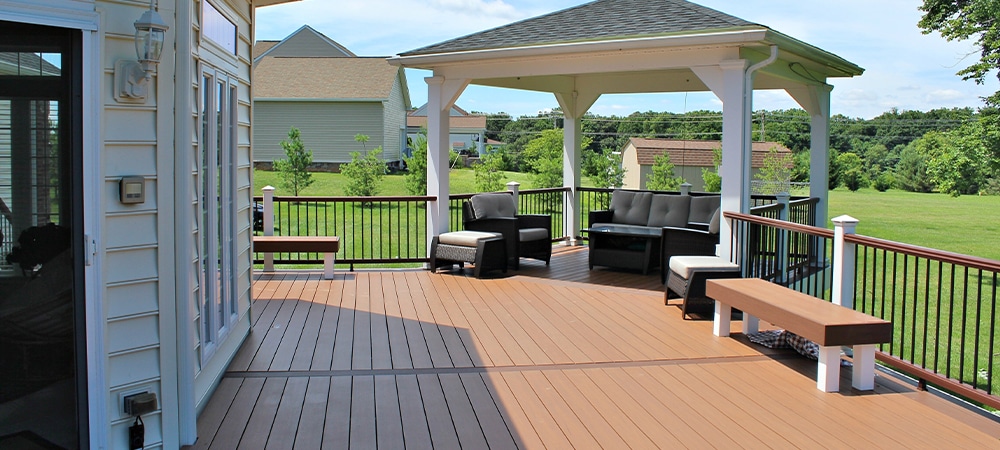
Installation and Warranty Support
Hidden clip systems keep surfaces fastener-free.
TimberTech’s CONCEALoc and FusionLoc clips fit grooved boards and work with collated gun nails for rapid jobs. Trex uses the universal Hideaway clip, sold in stainless steel or plastic. Both kits come with colour-matched face screws for picture framing and stairs.
Warranties differ in length and coverage.
TimberTech Advanced PVC posts a 50-year fade and stain guarantee plus a limited lifetime structural promise for residential installations. PRO and EDGE drop to 30 and 25 years on fade respectively. Trex offers a 25-year fade and stain warranty across all lines, backed by a 25-year structural term.
Installer networks matter.
TimberTech’s Contractor Loyalty program and TrexPro accreditation help homeowners vet crews. Choosing a certified installer protects the labour portion of your warranty, so ask for credentials before signing.
Eco Credentials
Sustainability pushes many homeowners toward composite.
TimberTech converts hard-to-recycle PVC and PE into deck boards, saving more than 136 million kg of waste a year. Its closed-loop water system reuses nearly all process water.
Trex reclaims roughly 400 million kg of polyethylene film and wood waste annually. A school recycling challenge helps students trade plastic for benches, boosting community engagement.
Both brands are members of the Canada Green Building Council. For LEED projects, their Environmental Product Declarations and Health Product Declarations support credit submissions.
In short, whichever board you choose, landfill savings follow.
Related Article: How to Resurface a Deck with Trex
Quick Decision Matrix
| Factor | TimberTech | Trex |
| Cooler surface | Advanced PVC stays coolest | Warmer under direct sun |
| Colour variety | Up to 20 shades, multi-width | 14 shades, classic tones |
| Longest fade warranty | 50 years on Advanced PVC | 25 years across lines |
| Budget entry point | EDGE from $6/ft | Enhance from $4.50/ft |
| Heaviest board feel | WPC lines mid-weight | WPC core feels solid |
| Full-wrap cap | Yes (all sides) | Three-sided cap |
Use the matrix as a shortcut, then weigh which traits match your lifestyle.
Related Article: Decking Trends to Watch in 2025
Making Your Deck Decision
Choosing between TimberTech and Trex comes down to priorities. If you crave a cooler surface, a wide palette and the security of a 50-year fade pledge, TimberTech Advanced PVC delivers. If your budget is tight or you prefer the familiar heft of wood-plastic composite, Trex Enhance or Select offers proven value.
Whichever path you take, professional installation is the final piece. Green Side Up Contracting has built hundreds of composite decks across the GTA and York Region, guiding homeowners from design to final walk-through.
Reach out today for a free, no-pressure quote and turn that backyard dream into a durable reality.


